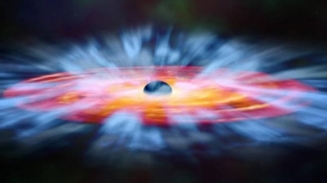
类星体放出20%于光速的风
Quasar Winds Clock In at a Fifth of Light Speed
类星体放出20%于光速的风
播音/撰文 克里斯托弗·因塔利亚塔 (Christopher Intagliata)
翻译 Meatle
审校 Arc Ma
Quasars can shape the evolution of their galaxies, by blasting 135-million-mph winds.
类星体可以通过鼓出1.35亿英里每小时 (约2.17亿公里每小时) 的风来塑造它们所在的星系。
Black holes are not all created equal. There are the regular star-sized ones. And then the supermassive black holes. Which really live up to their name. "So the Milky Way has a supermassive black hole sitting at the center weighing upwards of four million times the mass of the sun. They're monsters." Jesse Rogerson, an astrophysicist at York University in Toronto.
黑洞并非生而平等。宇宙中有恒星大小的黑洞,也有超级巨大的黑洞,而这些巨大黑洞确实不辜负“巨大”之名。“在银河系的中心存在一个质量为太阳四百万倍的怪物般的超级黑洞。”多伦多约克大学的天体物理学家杰西·罗杰森说道。
Rogerson studies the sites of the most violent, most active supermassive black holes: quasars. "They're pretty much some of the most extreme things you'll find in the universe."
罗杰森研究宇宙中最为暴力、最为活跃的超级黑洞——类星体所在的宙域。“它们是你们能在宇宙中找到的最为极端的天体之一了。”
The black holes at their centers of quasars gobble up massive amounts of gas and dust, "and that heat, that radiation that's created from the [stuff] falling in, it actually turns itself into a disc of stuff falling in, kind of like circling the drain almost. And that accretion disk is so bright it can outshine the entire galaxy within which it resides."
在类星体中央的黑洞贪婪地吞噬着四周的气体和尘埃,“而类星体的热量和辐射来自于那些被黑洞吞噬的物质,被黑洞吞噬的物质塑造出类星体的碟型的形状,就像排水口的漩涡一样。而这个闪亮的吸积盘的亮度让它所在的星系相型见拙。
That disk isn't just bright—it’s also blazing hot. And that intense heat creates winds. Think of a massive hairdryer, like the size of our solar system, blowing away galactic gas and debris. Rogerson and his colleagues aimed the Gemini Observatory on one such quasar, called J0230, about 11 billion miles light-years away. And they tracked a cloud of gas blowing away from J0230 and clocked the speed at 135 million miles per hour—a fifth the speed of light. Or, as Rogerson describes it, equivalent to a category 77 hurricane. The worst hurricanes here on Earth are category 5. The study is in the Monthly Notices of the Royal Astronomical Society.[Jesse A. Rogerson et al, Multi-epoch observations of extremely high-velocity emergent broad absorption]
吸积盘不仅很亮,而且还相当热。而那热量足以产生风。想象下一个非常巨大的吹风机,就如我们的太阳系一样巨大,吹走大量的宇宙尘埃和碎屑。罗杰森和他的同事将双子星天文台 (Gemini Observatory) 对准了被称为J0230的一个类星体。他们追踪了J0230吹出的一团气状物,这股“气体”的速度到达1.35亿英里每小时 (约2.17亿千米每小时) ,约为光速的20%。或者像罗杰森说的那样,它就像77级的飓风。而地球上存在的最强飓风才5级。该研究发表在《皇家天文学月刊》。
These galactic gales, Rogerson says, could shape their galaxies. Think for example of a cloud of star-forming gas in the outer reaches of its galaxy. "It's collapsing down, it's condensing down, stars are growing inside clouds, and planets are growing out of that. Then you have a quasar turn on, start dumping massive amounts of material, pushing, it's like having a hurricane blast wind smack into your nice comfy little cloud that's currently building a solar system. It could easily disrupt that, turn that off, and stop the stars from growing, and then you end up having a galaxy that didn't grow a lot of stars."
罗杰森认为,这些宇宙强风会塑造类星体所在的星系。举个例子来说,在一个星系的外围,有一团恒星构成气。“它正在坍缩,冷却,孕育着恒星与其他天体。然后一个类星体介入,开始向那团星云倾注大量的物质,并吹跑这些物质,就像风卷残云那样吹走那些孕育星体的尘埃和气体。这种介入会轻易地打断天体的形成,并阻止恒星的生长,最终的结果就是,星系中不会产生过多的天体。”
The quasar, then, might be almost like a shepherd: guiding the evolution and, ultimately, determining the fate, of its flock of billions and billions of stars.
类星体和牧羊人一样:控制着星系的演化,最终决定了数以亿计的恒星的命运。
未经书面许可任何人不得复制或镜像
京ICP备11000850号-1
 京公网安备11010502039775号
京公网安备11010502039775号 信息网络传播视听节目许可证0111611号
国家科技基础条件平台

















